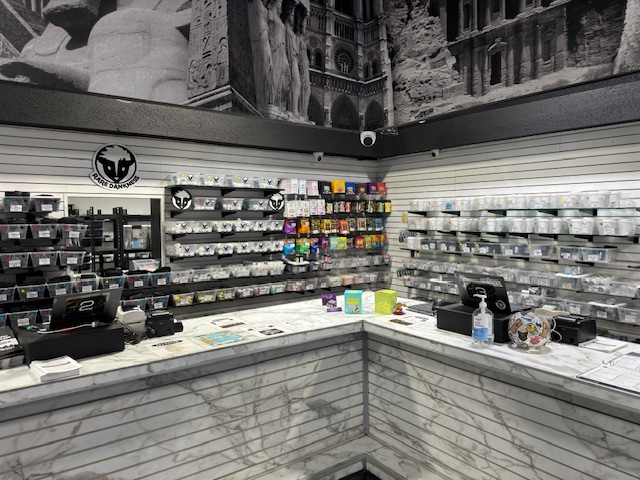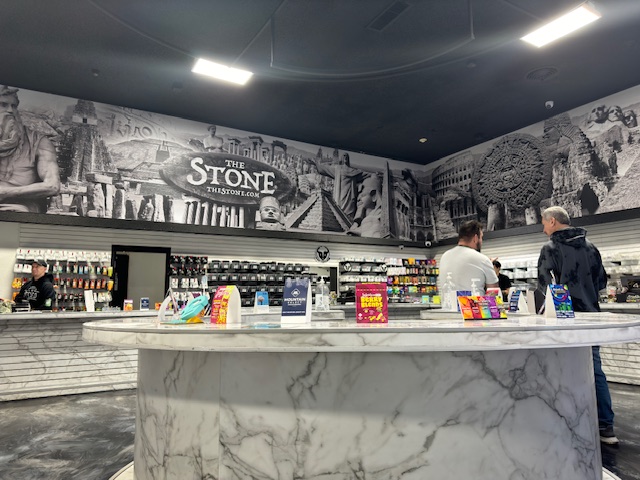
This website is for users aged 21 and over. Please confirm your age.

Cannabis consumption is a practice as old as time itself and continues to be prevalent in Denver. In this section, we take a walk down history lane and explore the origins of cannabis, its domestication, and its journey to America. Our sub-sections will dive into the role of cannabis in Central America and North America. Get ready to time travel and witness the evolution of cannabis with us. See how the rich history and evolution of dispensaries in Denver and their impact on the city matters.
Humans have been cultivating cannabis plants for thousands of years. This has led to varied strains with different THC and CBD levels. All this started in Central Asia around 12,000 years ago. Then, it spread to other parts of the globe such as Europe, Africa, and the Americas.
Indigenous people in the Americas used Cannabis Sativa for medical, spiritual, and fiber production. Different strains emerged due to environmental factors and local cultivators’ preference. Mexico’s sativa strains were popular in the US in the early 20th century. Later, higher-THC Indica strains took over.
The fact is the kinds of history connected to cannabis and its evolution cannot be dismissed when we see the impact of Denver dispensaries overall.
Today, controlled environments let cultivators tailor their product to customer requirements. This involves keeping the optimal temperature, humidity, and providing specific nutrients.
Pro Tip: To meet customers’ needs, cannabis domestication relies on environmental controls.
Cannabis has a long history in the Americas. Evidence of its use reaches back thousands of years. Indigenous tribes used it for healing and spiritual purposes. It likely arrived from Asia. Over time, it became an essential part of traditional medicine. Europeans also found it useful for textiles and medical treatments. This is mainly what the history of cannabis looks like, while its evolution is another matter.
However, newcomers misunderstood its use. This led to restrictions. Despite this, Cannabis was still used for health benefits throughout North America. Its potential as a healing agent gained global attention. But laws and regulations made it less accessible. Recently, these laws have been reformed, making Cannabis more accessible.
Cannabis has a lengthy past in Central America. Indigenous people have employed it for spiritual and medicinal purposes for centuries. It is thought to have come from Central Asia. But it was Spanish physician Francisco Hernandez who first noticed its healing properties in 1545 in New Spain (modern Mexico and Central America).
In our current times, countries like Costa Rica, Guatemala, Honduras, and Panama are growing and trading cannabis. Despite attempts to stop it, many small-scale farmers carry on with illegal cultivation to make money.
Thus, policymakers should take into account the economic possibilities of cannabis in Central America and its cultural value as the global industry continues to expand. Investors must also keep a lookout for changes to legalization regulations in the region to not miss out on future market expansion chances.
Cannabis has been part of North American history for centuries. Native American tribes used it for spiritual and medicinal purposes to treat ailments like pain, nausea and anxiety. Doctors even prescribed cannabis for a range of conditions.
Attitudes shifted in the early 20th century, though, and cannabis became demonized. But people still used it. The 60s and 70s saw increased usage, especially among young people and counterculture movements. The War on Drugs in the 80s meant tougher penalties, but didn’t stop people from using it.
Recently, there’s been a resurgence of interest in the potential benefits of cannabis. This has led to more legalization across North America for both medical and recreational use. Canada has even legalized recreational marijuana federally. Several states in the US have too.
Despite the risks and benefits debate, it’s clear cannabis has an important role in North American history. Colorado was the first to legalize recreational marijuana, but other states are sure to follow and make money off the green rush.
Colorado has been at the forefront of the legal cannabis movement and opened the doors to something that was once taboo: marijuana. The legalization of cannabis in Colorado is a complex interplay of political and economic factors. In this section, we will explore the history of the legalization of marijuana in Colorado and its impact on Denver, the capital city of Colorado. We will dive into three sub-sections that outline:
The decriminalization and legalization of medical marijuana brought huge changes to Colorado’s legal status of cannabis. In 2000, patients with serious illnesses could buy and use cannabis with their doctor’s recommendation without worrying about criminal charges. Then in 2012, Colorado became the first state in the U.S. to fully legalize recreational marijuana for adults through Amendment 64.
These medical marijuana-focused dispensaries then received licenses to sell recreational marijuana too. This allowed more customers to purchase medicinal as well as recreational cannabis, which was profitable for Denver’s economy.
Nowadays, many dispensaries offer both medicinal and recreational sales. However, federal policies remain unclear, leaving people unsure about the future of cannabis legalization. Nevertheless, the market is evolving quickly and more reforms could be made soon.
On January 1, 2014, Colorado legalized recreational marijuana. This was after the Amendment 64 ballot initiative was approved by voters in November 2012. People aged 21 years and older could legally possess and use cannabis. Retailers were allowed to sell it to recreational users. Colorado was one of two states in the US to have such sales. Individuals could buy up to an ounce of marijuana at a time.
Public consumption was still illegal. Retailers had to follow strict regulations, including labeling and reporting sales. This decision boosted Colorado’s cannabis industry and generated tax income.
Concerns were raised about the risks of legalization. But studies suggest these worries weren’t realized. In fact, sales exceeded expectations. It contributed to the state’s economy beyond its immediate market impact. Colorado’s move may be a model for other states considering similar legislation.
Colorado legalized recreational, medical, and decriminalized marijuana use, resulting in more licensed cannabis stores in Denver. An HTML table with year, number of recreational shops, and medical shops was created. It showed that from 2014 to 2017, the number of recreational and medical shops increased.
| Year | # of Recreational Shops | # of Medical Shops |
|---|---|---|
| 2014 | 50 | 60 |
| 2015 | 75 | 80 |
| 2016 | 100 | 110 |
| 2017 | 125 | 140 |
Colorado reported $1 billion in legal marijuana sales in 2019. Legalization has positively impacted commercial real estate owners, who have enjoyed increased tax revenue. The industry looks set to continue growing in Denver.
In Colorado, the cannabis industry has grown a lot since the state started giving out licenses for production, distribution, and sale. The number of licenses given by the state shows how big the industry is. We can make a table to show license types, active licenses, and total applicants.
License types can be grouped into 3 categories: Production, Distribution, and Retail. Active licenses means businesses operating with a valid license. Total applicants are the total applications the state got for each license type.
Getting a cannabis license in Colorado is tough. It needs a lot of paperwork and rules from local and federal authorities must be followed. Every application must be checked many times before it is approved or not.
It’s important to remember that getting a license is one piece of starting a successful cannabis business in Colorado. Rules and regulations must be followed to keep running. Data from the MED website says not all firms with licenses have kept running. This shows the challenges new companies will face in this changing industry.
| License Type | Active Licenses | Total Applicants |
|---|---|---|
| Production | … | … |
| Distribution | … | … |
| Retail | … | … |
Colorado’s legalization of both medical and recreational marijuana has had a major effect on the state’s economy. In 2020, marijuana sales in Colorado exceeded $2 billion dollars. The majority of that revenue was from recreational sales, at almost $1.5 billion.
The tax money gained from cannabis sales has benefited not just the state, but also local communities. Part of that money goes towards public services like healthcare and education. So, marijuana sales have brought economic growth to Colorado.
In recent years, recreational marijuana sales have been increasing. In 2020, they made up 75% of total cannabis sales, surpassing medical sales. This is due to the legalization of cannabis and the decreasing stigma surrounding it.
All in all, cannabis sales have had an incredibly positive effect on Colorado’s economy, making it a great example for other states to look to when considering legalizing marijuana.
Denver’s evolving relationship with cannabis has had a significant impact on the city’s real estate market. In this section, we’ll explore the effects of this booming industry on Denver’s property market. And how the evolution since the challenging history, facilitates including increased demand for commercial and industrial properties and a positive impact on commercial real estate owners.
With the legalization of marijuana, Denver has seen significant shifts in real estate trends, and we’ll investigate how this market has changed over time.
Colorado’s marijuana legalization has caused a staggering rise in the need for commercial and industrial properties. Cannabis businesses require space for cultivating, storage, and manufacturing – this has made landlords charge higher rent. Real estate developers have seen a great opportunity to either renovate or construct properties catering to cannabis dispensary industry needs, a good sign of the evolution of cannabis in Denver.
Existing properties have also undergone renovations to accommodate these businesses. This has raised lease rates, making real estate owners experience an increase in their property values. Revenue has been positively impacted.
The demand for commercial and industrial properties is anticipated to continue as the cannabis industry expands and new players enter. Real estate developers will keep investing due to potential growth and profitability.
The legalization of cannabis in Colorado has had a major beneficial effect on commercial real estate proprietors, since its tumultuous history. Since its evolution, demand for dispensaries and industrial properties from marijuana businesses has caused prices and rental rates to jump. This is due to zoning laws that prohibit marijuana businesses from certain areas, making them more concentrated in specific locations.
Landlords who lease to these businesses often enjoy long-term leases with reliable tenants who pay rent on time and take care of the properties. Furthermore, these businesses tend to invest heavily in improving the properties, leading to higher value for the real estate. Which is a major benefit for property owners and dispensary operators in Denver.
Many commercial real estate owners have taken advantage of this trend by converting old or outdated properties into desired spaces. They do this by investing funds into upgrades. As the marijuana industry grows in Colorado, it’s expected that this positive effect will benefit not only commercial real estate owners, but also nearby communities through increased tax incomes and job creation.
The economic impact of the marijuana industry in Colorado is undeniable, with dispensary sales contributing significantly to the local economy. In this section, we’ll discuss the marijuana industry in Colorado, the decisions made by local jurisdictions to allow sales of medical and recreational marijuana, and the sales figures associated with both categories. We’ll also take a deeper dive into the combined marijuana sales figures in Colorado, providing insightful data backed by sources about the economic impact of dispensaries on the city of Denver.
The marijuana industry in Colorado has become a significant contributor to the state’s economy. It includes cultivation, distribution, and sale of cannabis products.
Throughout its history, Medical marijuana was legalized in 2000 and decriminalized in 2012. Recreational use was legalized in 2014. This evolution caused demand to surge, leading to over 550 licensed dispensaries in Colorado – catering to both medical and recreational needs.
In 2020, combined sales from dispensaries surpassed $2.19 billion. This generated approximately $387 million in tax revenue for the state. These taxes mostly go towards education initiatives.
The industry has also created thousands of jobs throughout Colorado. Dispensary owners have become important stakeholders in Denver’s real estate market. They are renting out spaces to accommodate their growing businesses.
To sum up, Denver allowing medical or recreational marijuana retail dispensaries can have a significant effect on a local jurisdiction’s revenue. Colorado’s example shows that if managed correctly, the marijuana industry can bring a great source of revenue and employment for a state.
Local jurisdictions’ decisions to permit medical or recreational marijuana stores are essential for the success of the cannabis industry. In Colorado and other areas that have allowed such dispensaries in Denver, since its evolution, there has been a major, positive effect on the economy and housing market.
The financial impacts of permitting these stores are immense. Revenue generated from these sales can boost a community’s wealth. Areas with these stores have seen increased business growth, which creates more job opportunities than places where marijuana is illegal.
Allowing these stores also provides people with legal cannabis products that meet regulatory standards, keeping public safety in mind. If local jurisdictions do not allow these businesses, potential job creation and tax revenues may be missed out on.
It’s vital for local jurisdictions to think about the advantages and disadvantages of permitting these stores. Any decision made can strongly affect the community. Permitting licensed businesses to operate legally offers economic benefits while ensuring product quality.
In conclusion, the choice of local jurisdictions to allow medical or recreational marijuana retail stores is a money-making boon for Colorado’s economy.
The cannabis industry in Colorado has seen huge growth since legalization. Sales for recreational and medical use are divided. The table below shows that, after recreational marijuana was legalized, sales increased significantly compared to medical marijuana. Legal sales have earned lots of money, from these Denver dispensaries, and sales have grown yearly. It is important to remember this data only covers legal sales. Illegal activities may still be happening which could affect the total marijuana sales in Colorado.
| Year | Recreational | Medical |
|---|---|---|
| 2014 | $699 million | $386 million |
| 2015 | $996 million | $414 million |
| 2016 | $1.3 billion | $437 million |
| 2017 | $1.5 billion | $467 million |
Legalizing medical and recreational marijuana has supercharged Colorado’s marijuana industry. Figures display the growth of the industry over time, distinguishing between medical and recreational sales.
A table summarizes total sales in Colorado since legalization. It’s easy to see the increase in sales and the difference between medical and recreational marijuana.
…
Total marijuana sales at the Denver dispensaries show the evolution since starting. They have made a huge impact on the state’s tax revenue. This has funded education, infrastructure, public safety, health care, and other state services – all for the benefit of Colorado residents.
Denver’s dispensaries have had a huge impact on the city. Many have been in business for decades, catering to medical and recreational customers. Since marijuana was legalized in Colorado, dispensaries have become more widespread, boosting tourism and income.
Alternative Medical Services was the first dispensary in Denver. This triggered other dispensary openings and progressive legal changes. Now, they are user-friendly stores, making buying cannabis more enjoyable.
However, there are issues. The federal government’s attitude towards marijuana is unclear, causing banking and security issues. Some worry about the effect of legalization on young people and possible impaired driving.
In summary, dispensaries have changed Denver’s economy, culture and laws. Yet they cannot change the plants history, or evolution into becoming part of Denver’s dispensary options. There are still problems to tackle, but the future of marijuana in Denver looks bright, with dispensaries continuing to serve medical and recreational consumers.
Cannabis and hemp have been present in Colorado since the beginning. It was growing wild nearly 10,000 years ago and was domesticated around 10,000 years ago, with different varieties bred for fiber, medicine, and recreation. Hemp was grown for its fibrous strains to make ropes and sails for ships and, was even grown on the plantations of founding fathers like George Washington and Thomas Jefferson. Cannabis oil was a common ingredient in medical treatments in the late 1800s when both hemp and cannabis were legal in Colorado.
A pointed point in Denver’s cannabis history and evolution, we also see some form of dispensaries in the mix.
Colorado decriminalized possession of cannabis in 1975 and legalized medical marijuana in 2000. In 2021, Colorado became the first state to legalize recreational cannabis, followed by Washington. Another interesting fact about the history of Denver dispensaries.
Medical and recreational cannabis legalization increases demand for commercial and industrial properties in green zones. 36 percent of commercial real estate owners report that cannabis legalization has had a positive impact on their business. Denver has a population of approximately 716,000 and 154 licensed cannabis stores, which means there is about one cannabis store license per 4,650 residents. The state of Colorado has issued 155 medical cannabis licenses, 206 recreational cannabis licenses, and 361 overall cannabis retail licenses, among others. The Colorado Department of Revenue collected $423 million in revenue from cannabis sales in 2021, and Denver’s cannabis industry generated $70 million in local sales tax in 2020. So, based on the struggles in cannabis history, the evolution of the industry Denver dispensaries are a positive for the state.
The Colorado Department of Revenue office research reports that revenue from the marijuana tax has been increasing every year since the legalization of cannabis. The department collected $423 million in revenue from cannabis sales in 2021.
Since 2012, Colorado legalized recreational marijuana through Amendment 64. Since then, 29 states and Washington D.C. have legalized medical marijuana and 8 states and Washington D.C. have legalized recreational marijuana. Vermont has also legalized marijuana starting July 1, 2018, and 11 other states are considering legalization.
Recreational sales have grown sharply since the beginning; grew wild point nearly to first sighting in Denver. In the first month that recreational marijuana stores opened in Colorado, recreational sales exceeded $14 million and medical sales were $32.5 million. In 2014, total annual recreational sales were $303 million, while medical sales totaled $380 million. By 2017, recreational sales had grown to almost $1.1 billion, and medical sales were almost $417 million. In 2017, combined marijuana sales in Colorado exceeded $1.5 billion. Not a bad start for the history and evolution of marijuana dispensaries in Denver!
We warmly welcome you to explore our highly acclaimed strains, concentrates, and edibles. Serving recreational clients with pride is our passion.
At our dispensary, you'll find a professional yet inviting atmosphere that prioritizes your comfort and privacy. Feel free to stop by at your earliest convenience to experience it for yourself. We can't wait to serve you!


